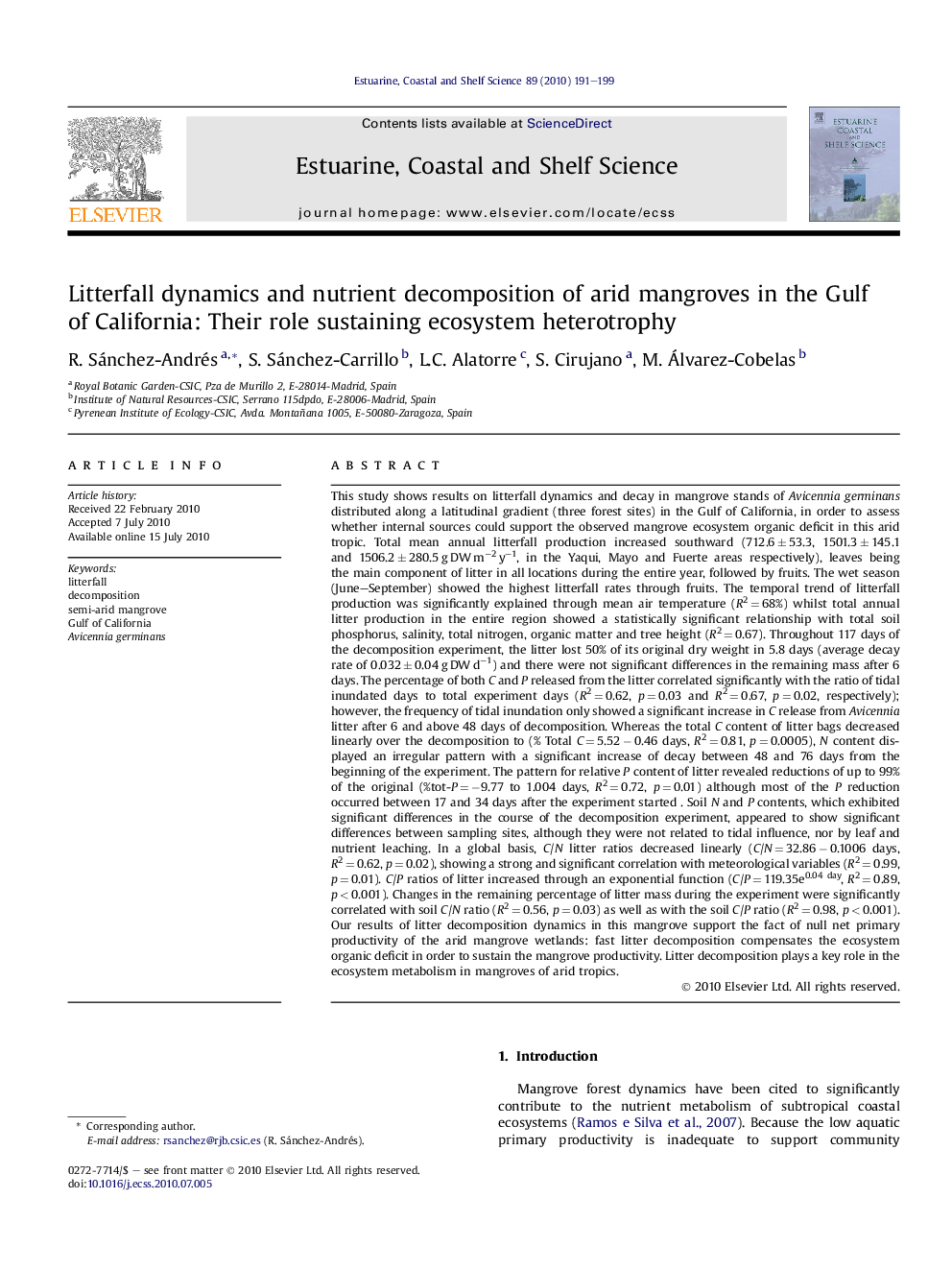| کد مقاله | کد نشریه | سال انتشار | مقاله انگلیسی | نسخه تمام متن |
|---|---|---|---|---|
| 4540762 | 1326690 | 2010 | 9 صفحه PDF | دانلود رایگان |

This study shows results on litterfall dynamics and decay in mangrove stands of Avicennia germinans distributed along a latitudinal gradient (three forest sites) in the Gulf of California, in order to assess whether internal sources could support the observed mangrove ecosystem organic deficit in this arid tropic. Total mean annual litterfall production increased southward (712.6 ± 53.3, 1501.3 ± 145.1 and 1506.2 ± 280.5 g DW m−2 y−1, in the Yaqui, Mayo and Fuerte areas respectively), leaves being the main component of litter in all locations during the entire year, followed by fruits. The wet season (June–September) showed the highest litterfall rates through fruits. The temporal trend of litterfall production was significantly explained through mean air temperature (R2 = 68%) whilst total annual litter production in the entire region showed a statistically significant relationship with total soil phosphorus, salinity, total nitrogen, organic matter and tree height (R2 = 0.67). Throughout 117 days of the decomposition experiment, the litter lost 50% of its original dry weight in 5.8 days (average decay rate of 0.032 ± 0.04 g DW d−1) and there were not significant differences in the remaining mass after 6 days. The percentage of both C and P released from the litter correlated significantly with the ratio of tidal inundated days to total experiment days (R2 = 0.62, p = 0.03 and R2 = 0.67, p = 0.02, respectively); however, the frequency of tidal inundation only showed a significant increase in C release from Avicennia litter after 6 and above 48 days of decomposition. Whereas the total C content of litter bags decreased linearly over the decomposition to (% Total C = 5.52 − 0.46 days, R2 = 0.81, p = 0.0005), N content displayed an irregular pattern with a significant increase of decay between 48 and 76 days from the beginning of the experiment. The pattern for relative P content of litter revealed reductions of up to 99% of the original (%tot-P = −9.77 to 1.004 days, R2 = 0.72, p = 0.01) although most of the P reduction occurred between 17 and 34 days after the experiment started. Soil N and P contents, which exhibited significant differences in the course of the decomposition experiment, appeared to show significant differences between sampling sites, although they were not related to tidal influence, nor by leaf and nutrient leaching. In a global basis, C/N litter ratios decreased linearly (C/N = 32.86 − 0.1006 days, R2 = 0.62, p = 0.02), showing a strong and significant correlation with meteorological variables (R2 = 0.99, p = 0.01). C/P ratios of litter increased through an exponential function (C/P = 119.35e0.04day, R2 = 0.89, p < 0.001). Changes in the remaining percentage of litter mass during the experiment were significantly correlated with soil C/N ratio (R2 = 0.56, p = 0.03) as well as with the soil C/P ratio (R2 = 0.98, p < 0.001). Our results of litter decomposition dynamics in this mangrove support the fact of null net primary productivity of the arid mangrove wetlands: fast litter decomposition compensates the ecosystem organic deficit in order to sustain the mangrove productivity. Litter decomposition plays a key role in the ecosystem metabolism in mangroves of arid tropics.
Journal: Estuarine, Coastal and Shelf Science - Volume 89, Issue 3, 10 October 2010, Pages 191–199